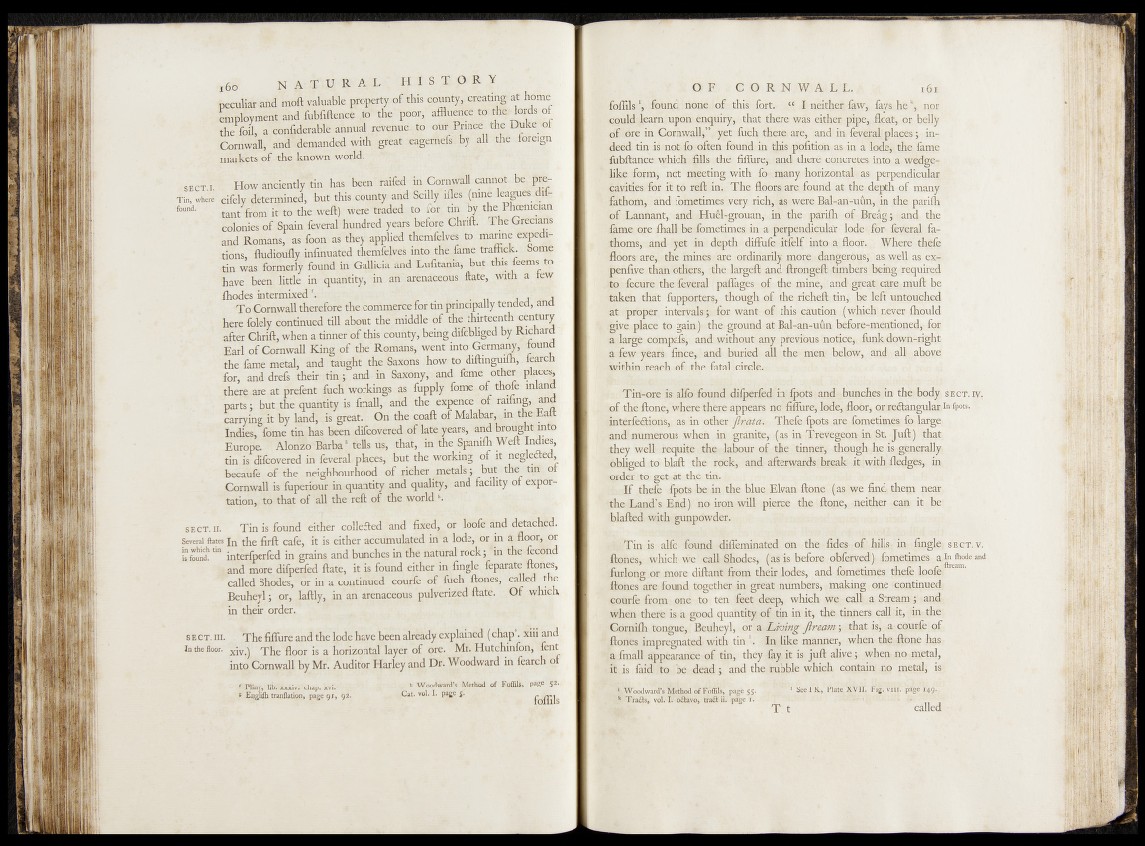
-SECT,I,
Tin, where
•found. - ’
SECT. IÏ.
Several ftates
in which tin
is, found.
SECT. HI.
In foe floor.
N A 'T .U R A. L { H I ^ P R
peculiar andmcJt v a lu ile ^ o ^ r ty ^ tk is M M P j ho“ e
affluence to
the foil«- a'cbnfiderable annual revenueWp onn Pririoe the Duke^of.
Cornwall, ^dllemanded with great'.eageAe^k^'#'the iWeign
markets of-the known woftd.
How ancientlytyn has. been’ raifed in Gornyftil cannot, be pre-
eif^dkermined, but this .county and Scffl£ifl& fpme leapes.d;£-
tant from ir to the weft) f were?ifeded.,to foty fin by the EtemJan
colonies of Spain feveral'hundred. years before‘Chtift/ 'The Grecians
and Romans, as foon as they applied themfelvj to maiine expeditions,
ftudioufly infinuated themfjves into th | | fe e traftick. Sortie
-tin was formerly found in G # c ia and Lufitania, but this feems_ to
have been little in quantity, in an arenaceous fete, with a J p y
ihodes intermixed V : ■ r ,, ^ * . . A
To Cornwall therefore the commerce for tin prmcipally tended, and
here foiely continued till about the middle of fhe thirteenth century
after Chrift, when a tinner o f this county, being difdbliged by Richard
End of Cornwall King of the Romans, went infe Germany, -found
the lame metal, and taught the Saxqns how'to diftinguilh,. fearck
for, and drefs their t in ; and4 n Saxony,! and fome other , phce|
there are at prefent fuch workings as fupply fome^o£.,thofe inland
parts ; but the quantity is finall, and the expence: of railing, and
carrying it by land, is great. On the coaft Gf MakbaW|.m tteiEaft
Indies, fome tin has been difcovered of late^years, ■ aridd#3%Wrmto
Euro{k.^!Mo^J-Bkrbas tells us, .that, M h e M n ilh Weft Indies,
tin is difcovcrcd in feveral. places, but the working of it J3gle<x£d, I
becaufe o f the neighbourhood of richer ^petals; but the tiif ol |
Cornwall is fuperiour. in quantity and quality, and facility of exportation,,
to that of all the reft of the world \
Tin is found either c o lie fte dW fixed* or ldofer and detached.
In the firft cafe, it is either accumulated in% ldde^ or in % lp q ^ r
interlperfed in grains and bunches in the natural rock; in th^^C|tod
.and more difperfed ftate, it is found e i th e r Mfingle feparate^ones,
mlied Shodes, or in a continued courfe of fiich ftones, called the
Beuheyl; or, laftly, in an arenaceous pulverized ftate. Of which
in their order.
The Allure and the lode have been already explained (chap . xiii and
xiv.) The floor is a horizontal layer of ore. Mr. Hutchinfon, fent
into Cornwall by Mr. Auditor Harley and Dr. Woodward in fearch of
1 Pliny, lib. xxxiv. chap. xvi.
s Englilh tranflation, page 91, 92.
... i> Woodward’s Method of FolSls, pag* S*‘
Cat. vól. I. page i k ,
fdiils
V O Fi- £ € O R N W M L ,% .A | 161
fnffil s» .j'ffoündjtrioneiofe thisfflbl ^ . c { F neith,C^ iaWyt faysgh^ \ nor
^quild Jkafh;ups^,.eii#uryif{that fher uithef',pipe,; tfipat, or belly
dKdre in Cornwall*’Vyet *febh th,er% arb, iandliti fev^^<places ^ indeed
tin';>is*ïnoftfo,soften foundtih this p^hja^i^a&in a lodtyi thejjja.pi\e
#ibftarice. whicbvfil'k, thê fiffur^japd theiê excretes? igjg a. w^cfge-
hke form, ndt^t^eting with ,aiot.r^anyrhoEiz©pfia%as perpendicular
&au&s/for if to reft- in^-The flóo^aarej,-fourid at the^dspfh^f many
fathom, ahd fometimes very rich,^%ywere Bal-arifdki^in the? pariflh
p f Lannant, and,, Huèlr-’grsuan,'’ in£|fe •^p^i|h»*pf'rEï^ag^|ran4 t %e
ipnae1, flialh be fometimes Wan'^EÉ^^cjilar IqdMfbr federal ?f§^
.thorns, andr-y.et in depth diffufe-iftfelf i|itp,'^fl^q'Bi;^ Whete thêfe
i&óorsjar&j&qke ipiings/ar,e. ordiharilj^^Qr^.d|.a^erèusy,'a»wel|.las,e^t
*|xenfive thaü*ètlfers, the Jargefl, ^ d ','ltrongeft.jt'iniber§ required
to fecure the feyetal p^ftages, o^> ,th%.mineji'Sanhigfea||1e^,©iiEiuft‘ .bq
taken that fuppoj;ter§, though, of' hpjrichefhjinyj^bè fteff uljtouished
at proper intetyalsS^for want pf this .Galntion^l wln6^ never- fftiöuld
i&e.,idace to gain&)'>'thogipu%d'atTBal-^!],-!y.h'%hfjNf^:ïHÉi^9^eÖ>^C^
fiaE^:,cdmpafs',-' and without/arty previous notice,t^lhsKd^W-right;
,a.-few years fince, and buried all thermen- hefehy, and alf^h§iye|
within jeach o f the fatal cirplb- - 1
jt Tiri-ore is' alio'found dilperfèdj inf lpots .and^bunchesdn the? body,
*pf the ftone, where’there appears no fiflure, lode, floor, orgeétangular;
jjtpterCedtions, dasdin' other Jtr$ata\w T-hefe. {pots, arfometimfS?- fG^Wgfe
anchnumerous when in granite,- (as inTrevegeqn^ihf-St. Juft,} that
ijthey well requite th& lahour of the tinner, ihgiugh^h^ l^gpierall)^
M g e d to blaft the rdek, and afterwards brjak it iwit-h^fledgips, ioa
Styider to get ,at the tin.
hi^If thefe fppts be in the blue;Elvan ftone (as>/,we find, diem near
‘the Land’s End) no iron will pierce the ftone, neither -can: it he
blafted with gunpowder. ;
^ T in is alfo found l^fleminated on th'e-flde^jof hilkkinjifinglpj
ftones, which we'" call- Shodes, (asIs befor&tobferved) .fcmeömes aj
furlong orj more diftant from their lodes, and- fómetijnes thefe lpofe,
ftones are found together in great numbers, ^making ®&e icoijltinjie^
courfe from .one to . ten -feet deep, which we,:call^a Stream; ;and
when there is a good quantity of tin in it, the tinners §||||it, ^gt|^i
Gornifh tongue, Beuheyl, or it Living Jlream; jrfiat is, Ka- c^upfe; o f
Rones impregnated with t®t*. In like manner, when the. Abne Jjja
^.fmall appearance pf tin, theyjfay it is juft alive; w-hen^o metal,
| | is faid to jbe dead; and th§j rubble which contain no rng^l, É
M g oo dw ard ’sMethod ofFoffilsj page 55. ' | 1 See IK , flate.jtylf. Fig viii pag& .M , '
k: Trafls, vól. !, öfilavo, traft-ii. page 1. ' 1 , ' 1 -
. T . t ■ •' , H pBpHp 1 ; v'v: called
;^1ct. jv.
In'fpotSi ’•
[SBCT..V.
In {hode and
picafn.